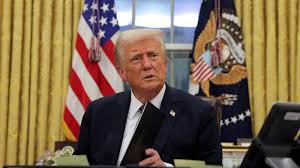
Introduction
On January 20, 2025, Donald Trump was inaugurated as the 47th President of the United States, marking a historic return to the White House. His inaugural address outlined key policy directions, and he promptly signed several executive orders, including one addressing the Russia-Ukraine conflict. This article delves into the details of his inauguration, the content of his inaugural speech, and the significant executive actions he undertook in his initial days back in office.
The Inauguration Ceremony
The inauguration of President Trump and Vice President J.D. Vance took place in the Capitol Rotunda, a departure from the traditional outdoor setting. This change was necessitated by a severe polar vortex that brought sub-zero temperatures across much of the country. The indoor ceremony was attended by a select group of dignitaries, lawmakers, and family members, ensuring the safety and comfort of all participants.
Highlights of the Inaugural Address
In his inaugural address, President Trump emphasized themes of national strength, economic revitalization, and a renewed focus on American interests. He reiterated his commitment to:
Economic Growth: Pledging to boost the economy through deregulation and tax reforms aimed at stimulating business investments.
National Security: Vowing to strengthen the military and adopt a more assertive foreign policy stance to protect American interests abroad.
Healthcare Reform: Promising to overhaul the healthcare system to increase accessibility and reduce costs for Americans.
Education: Advocating for school choice initiatives and reforms to improve educational outcomes.
Executive Orders Signed on Inauguration Day
Immediately following the inauguration, President Trump signed several executive orders to set his administration’s agenda into motion:
Withdrawing the United States from the World Health Organization (WHO): Citing dissatisfaction with the WHO’s handling of global health crises, the executive order directed the withdrawal of the United States from the organization.
Restoring Names That Honor American Greatness: This order reinstated the name “Mount McKinley” for the highest peak in North America and renamed the Gulf of Mexico to the “Gulf of America,” reflecting a focus on honoring American heritage.
Protecting the Meaning and Value of American Citizenship: Aimed at ending birthright citizenship for children of unauthorized immigrants and those temporarily in the U.S., this order reinterpreted the Fourteenth Amendment’s Citizenship Clause.
Addressing the Russia-Ukraine Conflict
Among the initial executive actions, President Trump signed an order addressing the ongoing Russia-Ukraine conflict. While the specific details of this order were not immediately disclosed, it signaled the administration’s intent to engage directly with the situation, potentially indicating a shift in U.S. foreign policy in the region.
Additional Executive Actions
In the days following his inauguration, President Trump continued to issue executive orders reflecting his policy priorities:
Removing Barriers to American Leadership in Artificial Intelligence: This order sought to enhance U.S. leadership in AI by revoking certain policies and establishing a plan to promote AI development free from ideological bias.
Federal Workforce Directive: An order mandating all federal employees to return to in-person work by February 6 or resign, emphasizing strict conduct standards.
Gender Recognition Policy: An executive action to terminate Diversity, Equity, and Inclusion (DEI) mandates at the federal level and to officially recognize only two genders: “male and female.”
Public and Political Reactions
The flurry of executive actions elicited a wide range of responses:
Supporters: Praised the swift implementation of campaign promises and the focus on national interests.
Critics: Expressed concern over the potential legal challenges and societal impacts of the orders, particularly those affecting immigration and healthcare.
Conclusion
President Donald Trump’s return to the White House has been marked by decisive actions aimed at reshaping U.S. policy across various sectors. His initial executive orders reflect a commitment to his stated priorities, setting the tone for his second term. As these policies unfold, they will undoubtedly influence the nation’s trajectory in the years to come.
FAQs
What were the key themes of President Trump’s inaugural address?
He emphasized economic growth, national security, healthcare reform, and education.
Which significant executive orders did President Trump sign upon taking office?
Notable orders included withdrawing from the WHO, reinstating traditional landmark names, and redefining birthright citizenship.
How did the public react to these executive actions?
Reactions were mixed, with supporters praising the swift action and critics voicing concerns over potential legal and societal impacts.
What changes were made regarding federal workforce policies?
An executive order mandated all federal employees to return to in-person work by February 6 or resign, emphasizing strict conduct standards.
How did the administration address the Russia-Ukraine conflict?
An executive order was signed to address the conflict, signaling a potential shift in U.S. foreign policy, though specific details were not immediately disclosed.








